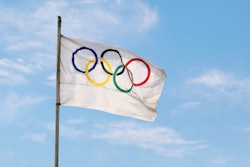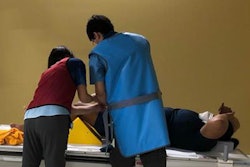
If an Olympic medal were awarded for medical imaging prowess, MRI would have won gold at the 2016 Summer Olympics in Rio de Janeiro. Almost 60% of imaging exams performed on athletes at the Summer Games were MRI scans, according to a new study published online February 26 in Radiology.
The findings highlight the important role that diagnostic imaging plays in the world of elite athletic competition -- and not just MRI, wrote a team led by Dr. Ali Guermazi, PhD, of Boston University. In fact, almost 10% of athletes who participated in the Rio Summer Games underwent some kind of imaging (Radiology, February 26, 2018).
"Competing athletes are the peak of their career and have trained and practiced for years to be able to participate in the games," Guermazi told AuntMinnie.com via email. "These elite athletes are at risk for injury, and onsite medical teams will do whatever is needed to ensure a fast return to competition. Referrers rely on the imaging team to establish a diagnosis fast and with high confidence."
Going for the gold
Imaging plays a key role in determining whether an injured athlete is able to return to competition. In cases of severe injuries that require acute intervention such as surgery, imaging can help physicians decide whether such a procedure needs to be undertaken onsite during the games or after athletes return home.
During the Rio 2016 Games, the Olympic Village polyclinic was open 24 hours a day, and the imaging center was open from 7 a.m. to 11 p.m. Medical and imaging services were available for 32 days from the opening of Olympic Village on July 24, through the period of competition (August 5 through 21), and to the closing of the Olympic Village on August 24.
In all, 11,274 athletes from 207 teams sustained 1,101 injuries (9.8%), and a total of 1,015 imaging exams were performed, including 304 x-rays (30%), 104 ultrasounds (10.2%), and 607 MRI exams (59.8%).
"In Olympic athletes, the cost of imaging is not a limiting factor, and thus radiography is not necessarily the first imaging examination performed to evaluate musculoskeletal pain," Guermazi's group noted. "Indeed, all imaging examinations, particularly the relatively more expensive MR examinations, were provided free of charge to the athletes in the Olympic Village."
Excluding from the cohort 10 athletes who were refugees, athletes from Africa had the highest imaging use rate, at 148 out of 1,001 (14.8%), while Europeans underwent the most imaging exams, with 103 x-rays, 39 ultrasound scans, and 254 MRI studies. Athletes from Europe also underwent the most radiologic examinations, while athletes from Asia had the fewest number of exams in all modalities and the lowest utilization rate, the researchers found.
Regarding particular sports, gymnastics had the highest percentage of athletes who underwent imaging, at 30 out of 194 (15.5%), while track and field had the most exams total, at 293 (53 x-rays, 50 ultrasounds, and 190 MRIs).
| Top 10 sports with highest imaging use at Rio 2016 Summer Games | |
| Sport | Percentage of athletes who underwent imaging |
| Gymnastics | 15.5% |
| Taekwondo | 14.2% |
| Beach volleyball | 13.5% |
| Handball | 13.1% |
| Cycling (motorcross) | 12.5% |
| Weightlifting | 12.1% |
| Judo | 10.8% |
| Volleyball | 9% |
| Aquatics (diving) | 8.1% |
| Wrestling | 8% |
Finally, Guermazi and colleagues discovered that use of imaging services peaked twice during the Rio 2016 Games, first on day 5 and second on day 12. The group attributed this to the scheduling of particular events.
"The second peak may be because the athletics, or track and field events -- which had the most imaging-depicted injuries among all sports -- were scheduled in the latter half of the games," they wrote. "Similarly, the first peak may be because judo, which had the second most imaging-depicted injuries among all sports, was scheduled in the first half of the games."
| Top 5 sports for number of injuries at Rio 2016 Summer Games | |
| Sport | Percentage of injuries |
| Athletics (track & field) | 34.6% |
| Judo | 9.6% |
| Gymnastics (artistic) | 7.7% |
| Volleyball | 7.1% |
| Weightlifting | 6.4% |
Imaging is crucial
Radiologists can take pride in the fact that their specialty is so important in the world of elite athletic competition, Guermazi told AuntMinnie.com.
"As someone who loves all kind of sports, I can say it was a fantastic experience to be onsite in a professional role as a radiologist at the Olympic Games," he stated. "Standing alongside the best athletes in the world during the Olympics is a paramount experience, and the interaction with local radiologists and physicians, as well as the International Olympic Committee medical team, was truly enriching and stimulating. Of course, we hope imaging will be used less frequently, with decreasing numbers of injuries in the future, but the reality is that imaging is crucial for establishing fast and relevant diagnoses."




.fFmgij6Hin.png?auto=compress%2Cformat&fit=crop&h=100&q=70&w=100)




.fFmgij6Hin.png?auto=compress%2Cformat&fit=crop&h=167&q=70&w=250)











